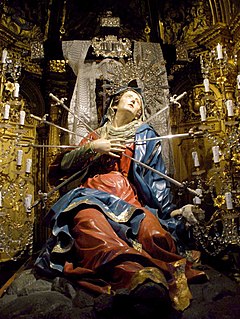
Dolenji Leskovec is a settlement west of Brestanica in the Municipality of Krško in eastern Slovenia. The area was traditionally part of Styria. It is now included with the rest of the municipality in the Lower Sava Statistical Region.

Arto is a settlement on the right bank of the Sava River in the Municipality of Sevnica in central Slovenia. The area is part of the historical region of Lower Carniola. The municipality is now included in the Lower Sava Statistical Region.

Dedna Gora is a small settlement in the hills south of Boštanj in the Municipality of Sevnica in central Slovenia. The area is part of the historical region of Lower Carniola. The municipality is now included in the Lower Sava Statistical Region.

Dolnje Orle is a small settlement in the Municipality of Sevnica in central Slovenia. It lies in the hills south of Sevnica in the historical region of Lower Carniola. The municipality is now included in the Lower Sava Statistical Region.

Gabrje is a small settlement on the right bank of the Mirna River in the Municipality of Sevnica in central Slovenia. The area is part of the historical region of Lower Carniola. The municipality is now included in the Lower Sava Statistical Region.

Goveji Dol is a small settlement east of Krmelj in the Municipality of Sevnica in central Slovenia. The area is part of the historical region of Lower Carniola. The municipality is now included in the Lower Sava Statistical Region. In 2006, Brezje, until then a hamlet of Goveji Dol, became an autonomous settlement. In 2008, a part of Goveji Dol and a part of Gabrje merged into a new settlement named Križišče.

Hinje is a small settlement southwest of Šentjanž in the Municipality of Sevnica in central Slovenia. The municipality is now included in the Lower Sava Statistical Region. The area was traditionally part of the historical region of Lower Carniola. The settlement, which was originally part of Koludrje, was established in January 1998 with a decree of the Municipality of Sevnica from 23 December 1997.

Kamenica is a small village northeast of Krmelj in the Municipality of Sevnica in central Slovenia. The area is part of the historical region of Lower Carniola. The municipality is now included in the Lower Sava Statistical Region. Until 2001, the settlement included the area of now autonomous settlement of Kamenško.

Koludrje is a small settlement south of Šentjanž in the Municipality of Sevnica in central Slovenia. The area is part of the historical region of Lower Carniola and is now included in the Lower Sava Statistical Region.

Krsinji Vrh is a small settlement in the Municipality of Sevnica in central Slovenia. It lies in the hills east of Mokronog in the historical region of Lower Carniola. The Municipality of Sevnica is now included in the Lower Sava Statistical Region.

Mala Hubajnica is a small settlement in the Municipality of Sevnica in east-central Slovenia. It lies in the hills south of Boštanj in an area that is part of the historical region of Lower Carniola. The municipality is now included in the Lower Sava Statistical Region.

Mrtovec is a settlement in the Municipality of Sevnica in central Slovenia. It lies northwest of Boštanj, above the right bank of the Sava River. The area is part of the historical region of Lower Carniola. The municipality is now included in the Lower Sava Statistical Region. The settlement includes the hamlet of Lisičje Jame.

Novi Grad is a small settlement in the Municipality of Sevnica in central Slovenia. It lies in the hills south of Vrhovo. The area is part of the historical region of Lower Carniola and is now included in the Lower Sava Statistical Region.

Pijavice is a small settlement in the Mirna Valley in southeastern Slovenia. The village lies southwest of Krmelj along the railway from Sevnica to Trebnje and the left bank of the Mirna River. Traditionally, it is part of Lower Carniola. Administratively, it is part of the Municipality of Sevnica. The municipality is included in the Lower Sava Statistical Region. The rail line from Sevnica to Trebnje runs through the settlement and has a station there.

Podboršt is a settlement southwest of Šentjanž in the Municipality of Sevnica in east-central Slovenia. The area is part of the historical region of Lower Carniola and is now included in the Lower Sava Statistical Region.

Studenec is a settlement in the Municipality of Sevnica in central Slovenia. The area is part of the historical region of Lower Carniola. The municipality is now included in the Lower Sava Statistical Region.

Velika Hubajnica is a settlement west of Studenec in the Municipality of Sevnica in central Slovenia. The area is part of the historical region of Lower Carniola. The municipality is now included in the Lower Sava Statistical Region.

Telče is a settlement east of Tržišče in the Municipality of Sevnica in east-central Slovenia. The area is part of the historical region of Lower Carniola. The municipality is now included in the Lower Sava Statistical Region.

Štajngrob is a small settlement west of Šentjanž in the Municipality of Sevnica in east-central Slovenia. The area is part of the historical region of Lower Carniola. The municipality is now included in the Lower Sava Statistical Region.

The Municipality of Škocjan, established in October 1994, is a municipality in the traditional region of Lower Carniola in southeastern Slovenia. The seat of the municipality is Škocjan. The Municipality of Škocjan is now included in the Southeast Slovenia Statistical Region. The majority of the municipality is part of the Novo Mesto Administrative Unit, except for the northeastern part, which belongs to the Sevnica Administrative Unit.













